Analysis of the Energy and Economic Effects of Green Remodeling for Old Buildings: A Case Study of Public Daycare Centers in South Korea
Abstract
1. Introduction
1.1. Background and Objectives of the Study
1.2. Methods
2. Green Remodeling Planning
2.1. Overview of Green Remodeling
2.2. Study Area
2.3. Passive Improvement Items
2.4. Active Improvement Items
2.5. Results of Green Remodeling
3. Feasibility Analysis of the Comprehensive Building Retrofitting Project
3.1. Analysis Procedure and Methods
3.2. Total Construction Cost Analysis
3.3. Results of the Feasibility Analysis
3.4. Economic Effects of Green Remodeling on South Korea
4. Conclusions
Author Contributions
Funding
Data Availability Statement
Conflicts of Interest
Nomenclature
| Symbol and units | |
| Heating energy demand for continuous heating, MJ | |
| Total heat transfer in heating operation, MJ | |
| Effective heat gain factor in heating operation | |
| Total heat gain in heating operation, MJ | |
| Cooling energy demand in continuous cooling, MJ | |
| Total heat gain in cooling operation, MJ | |
| Effective heat gain factor in cooling operation | |
| Total heat transfer in cooling operation, MJ | |
| Thermal equilibrium ratio in heating mode | |
| Coefficient according to the time constant, | |
| Reference coefficient | |
| Time constant of building zone, h | |
| Total heat capacity of building elements in direct contact with indoor air, J/K | |
| Heat capacity per unit area of building element j, J/m2K | |
| Area of building element j, m2 | |
| Thermal equilibrium ratio in cooling mode | |
| Coefficient according to the time constant, | |
| Real discount rate | |
| Fixed deposit rate | |
| Inflation rate | |
| Acronyms and Abbreviations | |
| COP26 | The 26th Conference of the Parties |
| IEA | International Energy Agency |
| ZEB | Zero-Energy Building |
| EPS | Expanded polystyrene insulation |
| PUR | Polyurethane insulation |
| SHGC | Solar heat gain coefficient |
| EHP | Electric heat pump |
| LED | Light-emitting diode |
| BEEC | Building energy efficiency certification |
| COP | Coefficient of performance |
| PEC | Primary energy consumption |
| EC | Embodied carbon |
References
- COP26 of United Nation. Available online: https://www.un.org/en/climatechange/cop26 (accessed on 31 October 2021).
- A European Green Deal. Available online: https://commission.europa.eu/strategy-and-policy/priorities-2019-2024/european-green-deal_en (accessed on 11 December 2019).
- Climate Action Plan 2050. Principles and Goals of the German Government’s Climate Policy. 2016. Available online: https://www.bmuv.de/en/ (accessed on 11 November 2016).
- Clean Energy For All. Available online: https://www.whitehouse.gov/cleanenergy/ (accessed on 27 January 2021).
- Clean Energy. Available online: https://www.energy.gov/clean-energy (accessed on 25 February 2021).
- Climate Change. Available online: https://www.meti.go.jp/english/policy/energy_environment/global_warming/index.html (accessed on 25 December 2020).
- An Energy Sector Road Map to Carbon Neutrality in China. Available online: https://www.iea.org/reports/an-energy-sector-roadmap-to-carbon-neutrality-in-china (accessed on 29 September 2021).
- Climate Change Act 2008. Available online: https://www.legislation.gov.uk/ukpga/2008/27/contents (accessed on 26 November 2008).
- EU Commission. Energy Efficient Buildings. Available online: https://commission.europa.eu/news/focus-energy-efficiency-buildings-2020-02-17_en (accessed on 17 February 2020).
- Net Zero by 2050. A Roadmap for the Global Energy Sector. Available online: https://www.iea.org/reports/net-zero-by-2050 (accessed on 18 May 2021).
- The Critical Role of Buildings. Perspectives for the Clean Energy Transition. Available online: https://www.iea.org/reports/the-critical-role-of-buildings (accessed on 24 April 2019).
- MOE in Korea. 2nd Plan for Climate Change Action. Available online: https://www.me.go.kr/home/web/policy_data/read.do?menuId=10259&seq=7394 (accessed on 13 October 2019).
- European Commission. Buildings Factsheet. Available online: https://ec.europa.eu/energy/eu-buildings-factsheets_en (accessed on 22 April 2020).
- MOLIT in Korea. Statistics on Buildings. Available online: http://www.molit.go.kr/USR/NEWS/m_71/dtl.jsp?lcmspage=1&id=95085286 (accessed on 18 June 2023).
- MOCST in Korea. Korea Green New Deal 2.0. Available online: https://www.korea.kr/special/policyCurationView.do?newsId=148874860#sitemap-layer (accessed on 30 September 2021).
- MOLIT in Korea. Green Buildings Construction Support Act. Available online: https://www.law.go.kr/ (accessed on 25 March 2022).
- Green-Remodeling Center of MOLIT. Available online: https://www.greenremodeling.or.kr/ (accessed on 18 June 2023).
- Gram-Hanssen, K. Existing buildings–Users, renovations and energy policy. Renew. Energy 2014, 61, 136–140. [Google Scholar] [CrossRef]
- Tajani, F.; Morano, P.; Di Liddo, F.; Doko, E. A model for the assessment of the economic benefits associated with energy retrofitting interventions: An application to existing buildings in the Italian territory. Appl. Sci. 2022, 12, 3385. [Google Scholar] [CrossRef]
- Farahani, A.; Wallbaum, A.; Dalenbäck, J.O. The importance of life-cycle based planning in maintenance and energy renovation of multifamily buildings. Sustain. Cities Soc. 2019, 44, 715–725. [Google Scholar] [CrossRef]
- Alabid, J.; Bennadji, A.; Seddiki, M. A review on the energy retrofit policies and improvements of the UK existing buildings, challenges and benefits. Renew. Sustain. Energy Rev. 2022, 159, 112161. [Google Scholar] [CrossRef]
- Oliveira, R.A.F.; Lopes, J.P.; Abreu, M.I. Sustainability perspective to support decision making in structural retrofitting of buildings: A case study. Systems 2021, 9, 78. [Google Scholar] [CrossRef]
- De Vita, M.; Mannella, A.; Sabino, A.; Marchetti, A. Seismic retrofit measures for masonry walls of historical buildings, from an energy saving perspective. Sustainability 2018, 18, 984. [Google Scholar] [CrossRef]
- Shaikh, P.H.; Shaikh, F.; Sahito, A.A.; Uqaili, M.A.; Umrani, Z. Chapter 9—An overview of the challenges for cost-effective and energy-efficient retrofits of the existing building stock. In Materials, Technologies, Optimization and Case Studies; Woodhead Publishing: Cambridge, UK, 2017; pp. 257–278. [Google Scholar]
- Toosi, H.A.; Lavagna, M.; Leonforte, F.; Pero, C.D.; Aste, N. Life cycle sustainability assessment in building energy retrofitting; A review. Sustain. Cities Soc. 2020, 60, 102248. [Google Scholar] [CrossRef]
- Zaho, D.; Mo, Y. Construction cost decomposition of residential building energy retrofit. Buildings 2023, 13, 1363. [Google Scholar] [CrossRef]
- Prabatha, T.; Hewage, K.; Sadiq, R. An incentives planning framework for residential energy retrofits: A life cycle thinking-based analysis under uncertainty. Sustainability 2023, 15, 5479. [Google Scholar] [CrossRef]
- Gabrielli, L.; Ruggeri, A.G.; Scarpa, M. Roadmap to a sustainable energy system: Is uncertainty a major barrier to investments for building energy retrofit projects in wide city compartments? Energies 2023, 16, 4261. [Google Scholar] [CrossRef]
- Kim, J.; Nam, S.; Lee, D. Current status of old housing for low-income elderly households in Seoul and green remodeling support Plan: Economic analysis considering the social cost of green remodeling. Buildings 2022, 12, 29. [Google Scholar] [CrossRef]
- Jun, Y.-J.; Ahn, S.-H.; Park, K.-S. Improvement effect of green remodeling and building value assessment criteria for aging public buildings. Energies 2021, 14, 1200. [Google Scholar] [CrossRef]
- Han, D.; Yoon, S. An analysis of energy saving effect of deteriorated detached house through green remodeling-Focusing on Nam-gu, Busan. J. Archit. Inst. Korea 2021, 37, 145–154. [Google Scholar]
- Woo, S.; Lee, S. An analysis of energy saving effect of green remodeling in public buildings for net-zero. J. KIEAE 2022, 2022, 19–26. [Google Scholar] [CrossRef]
- Korea Meteorological Administration. Available online: https://www.weather.go.kr/w/eqk-vol/search/korea.do?schOption=&xls=0&startTm=2018-01-01&endTm=2022-12-31&startSize=2&endSize=&startLat=&endLat=&startLon=&endLon=&lat=&lon=&dist=&keyword=&dpType=m3 (accessed on 18 June 2023).
- MOIS in Korea. Act on the Preparation for Earthquakes and Volcanic Eruptions. Available online: https://elaw.klri.re.kr/eng_mobile/viewer.do?hseq=55641&type=part&key=12 (accessed on 9 June 2020).
- Ahn, C.; Kim, M. Revitalizing the comprehensive performance improvement of existing buildings through green remodeling service. Mag. SAREK 2021, 50, 16–25. [Google Scholar]
- ISO 13790:2008; Energy Performance of Buildings—Calculation of Energy Use for Space Heating and Cooling. International Organization for Standardization: Geneva, Switzerland, 2008.
- DIN 18559:2018-09; Energy Efficiency of Buildings —Calculation of the Net, Final and Primary Energy Demand for Heating, Cooling, Ventilation, Domestic Hot Water and Lighting. Deutsche Industric Normen: Berlin, Germany, 2018.
- Moncaster, A.M.; Symons, K.E. A method and tool for ‘cradle to grave’ embodied carbon and energy impacts of UK buildings in compliance with the new TC350 standards. Energy Build. 2013, 66, 514–523. [Google Scholar] [CrossRef]
- Hammond, G.; Jones, C. Embodied Carbon: The Inventory of Carbon and Energy (ICE). In A BSRIA Guide; 2011; pp. 10–24. Available online: http://www.emccement.com/pdf/Full-BSRIA-ICE-guide.pdf (accessed on 18 June 2023).
- KEITI in Korea. Korea LCI DB. Available online: https://www.greenproduct.go.kr/epd/lci/lciDb.do (accessed on 18 June 2023).
- Shadram, F.; Bhattacharjee, S.; Lidelöw, S.; Mukkavaara, J.; Olofsson, T. Exploring the trade-off in life cycle energy of building retrofit through optimization. Appl. Energy 2020, 269, 115083. [Google Scholar] [CrossRef]
- MOHW. Child Care Statistics (2020). Available online: https://www.index.go.kr/unity/potal/main/EachDtlPageDetail.do?idx_cd=1583 (accessed on 31 March 2022).
- KRILA in Korea. Review and Feasibility Study Manual for Local Financial Investment Projects (2022). Available online: https://limac.krila.re.kr/instruction/manual/13?keyword=&page=1 (accessed on 13 September 2022).

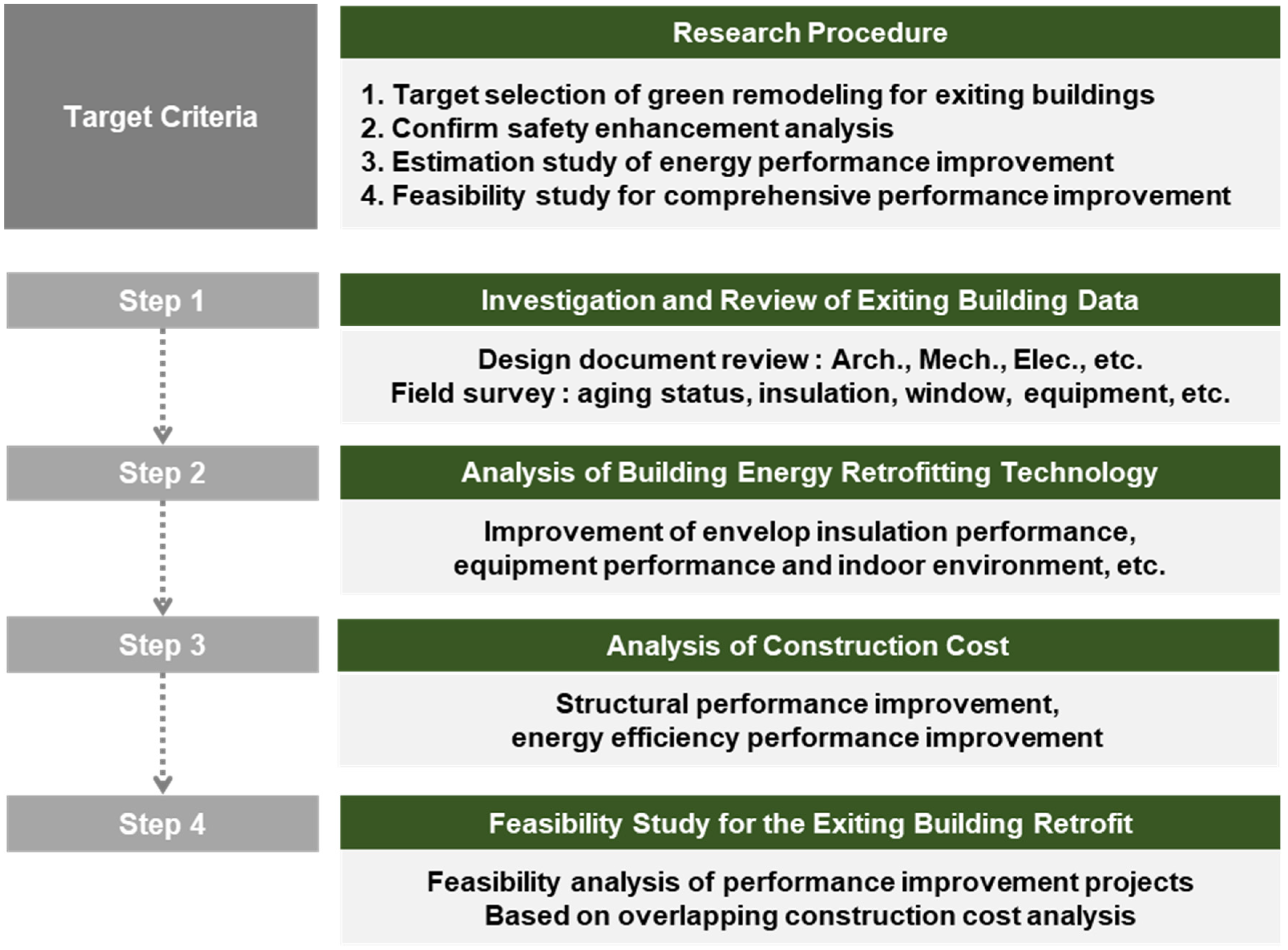
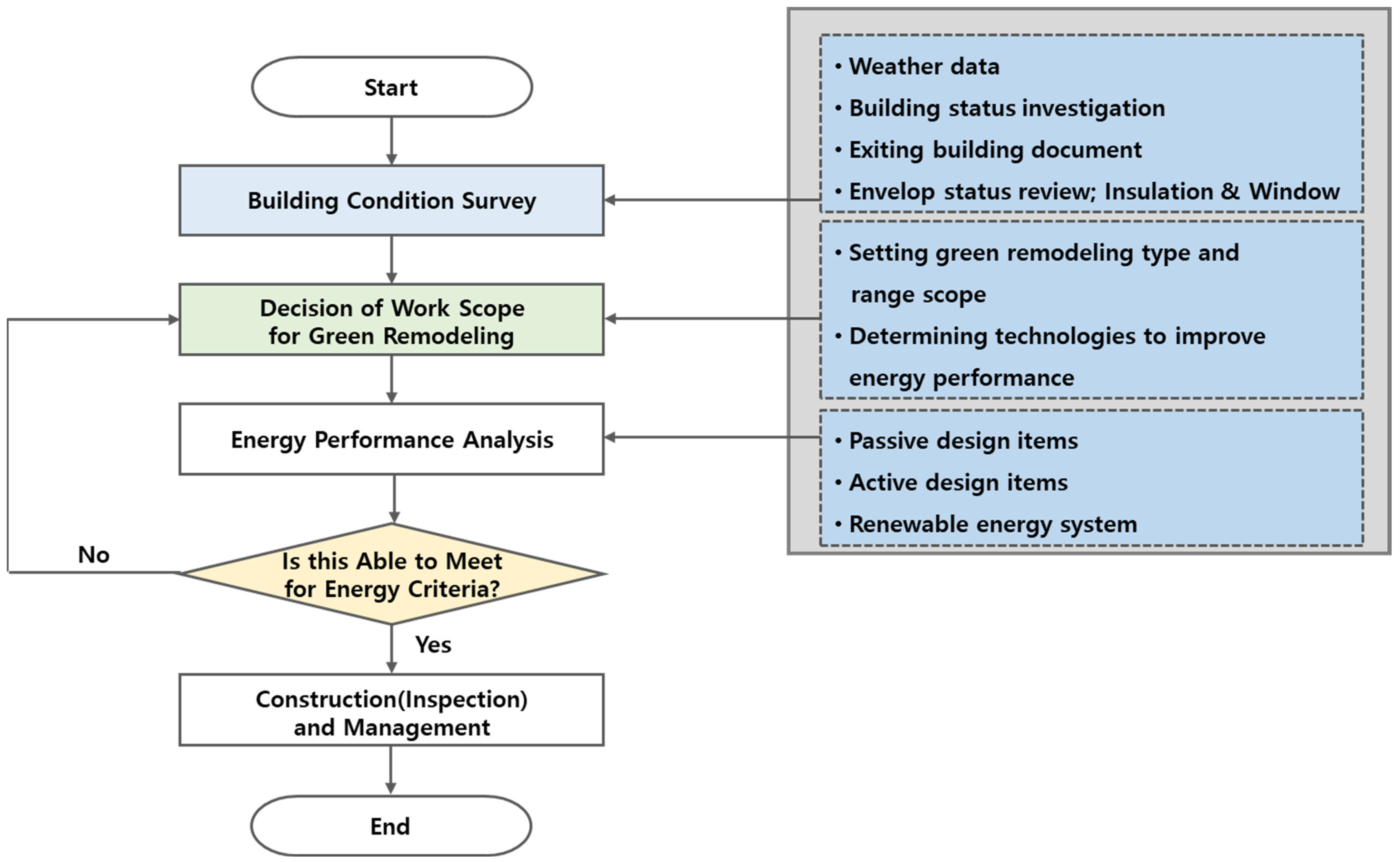



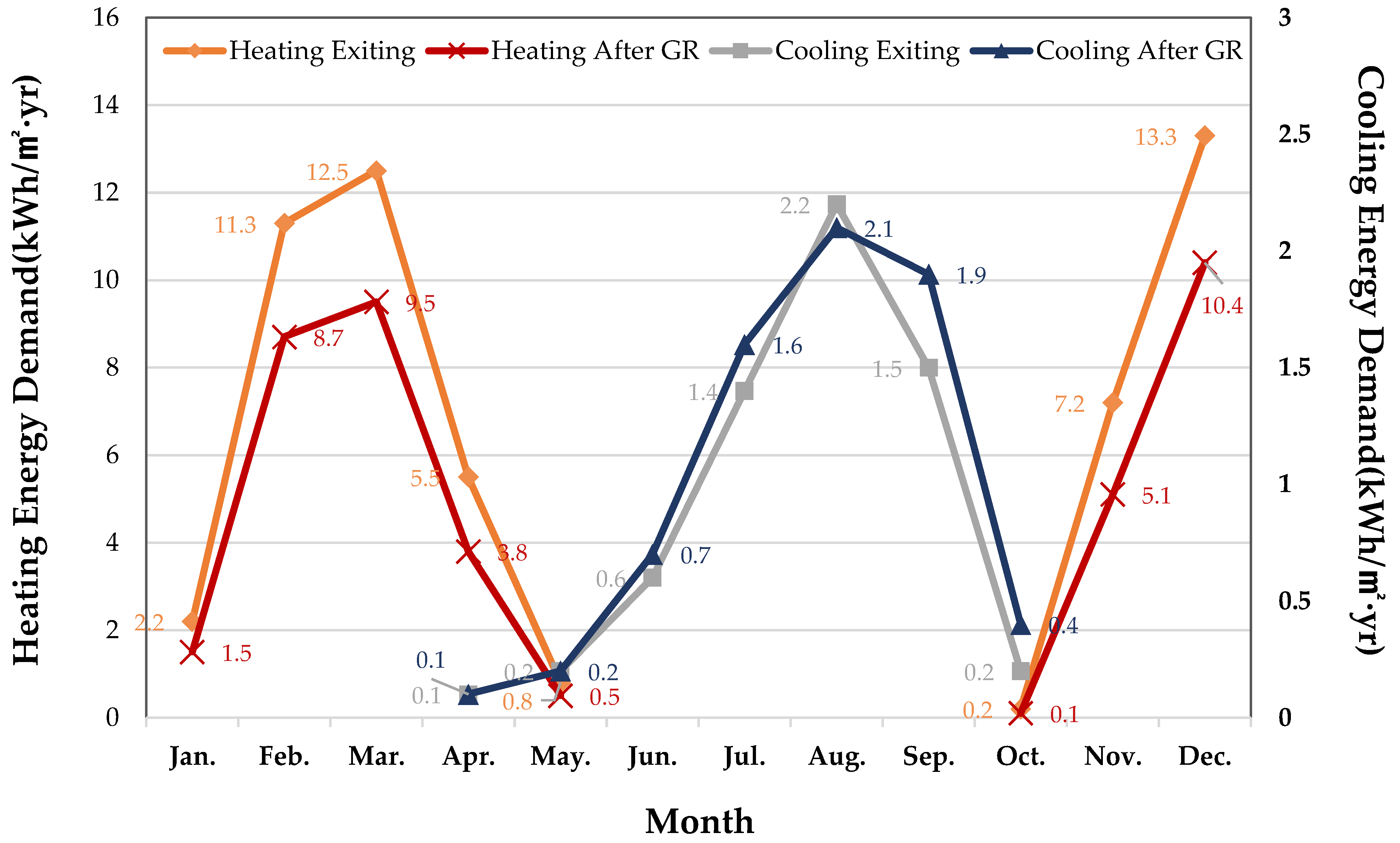



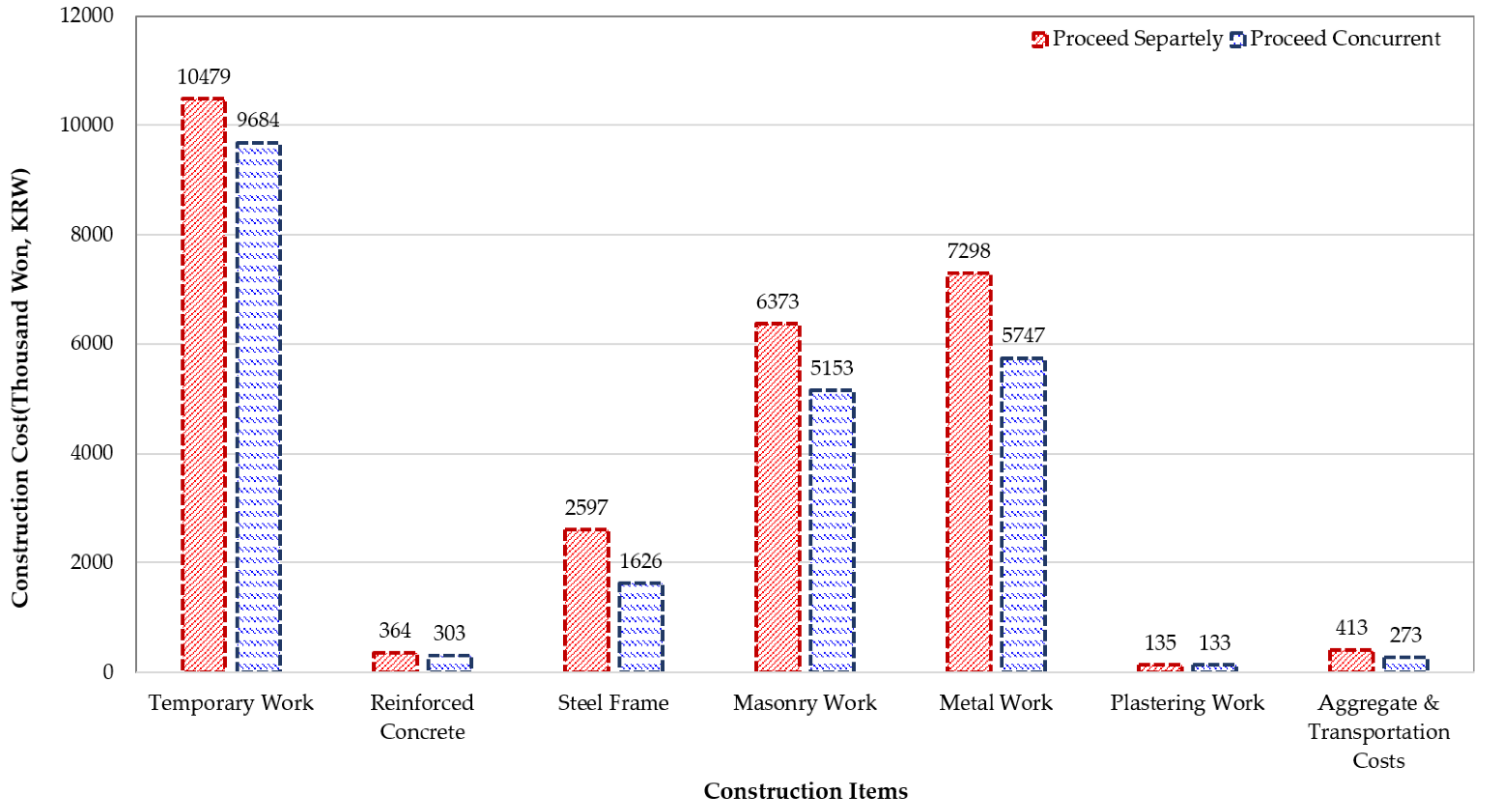
| Division | Policy | Target | Main Items |
|---|---|---|---|
| EU | Green Deal | Carbon adjustment mechanism (Carbon-neutral and growth strategy) | Industry decarbonization, renewable energy, building energy improvement and renovation, sustainable and smart mobility, and zero-pollution plan |
| Germany | Climate Action Plan | Compliance with the national and EU targets and net-zero GHG emissions by 2050 | Increasing renewable energy, electric mobility and infrastructure improvement, and building energy improvement and renovation |
| America | Clean Energy Revolution | Carbon neutralization for the entire economy | Building energy, renewable energy, electric power storage and grid, low-carbon transport, green hydrogen, and zero-carbon power generation |
| Japan | Decarbonization Plan | Decarbonization through green growth | Renewable energy, energy storage system, green mobility, green hydrogen, and zero-carbon power generation |
| China | Zero-Carbon China | Green recovery and low-carbon economic transformation | Renewable energy, energy-saving systems, fossil fuel to power conversion, and energy efficiency improvement |
| England | Climate Change Act | Realization of carbon neutrality through decarbonization of energy systems | Renewable energy, green hydrogen, nuclear energy, low-carbon transport, building energy, and sustainability |
| Division | EU | Republic of Korea | ||
|---|---|---|---|---|
| Residential Buildings | Non-Residential Buildings | Residential Buildings | Non-Residential Buildings | |
| Less than 10 years | 12.0% | 11.0% | 24.1% | 26.4% |
| More than 10 to less than 20 years | 16.0% | 17.0% | 27.0% | 27.1% |
| More than 20 to less than 30 years | 6.0% | 15.0% | 29.0% | 27.9% |
| More than 30 years | 66.0% | 57.0% | 19.9% | 18.7% |
| Division | Green Remodeling Criteria |
|---|---|
| Mandatory item | 1. High-efficiency item: Window (door) and insulation 2. Equipment: Heat recovery system and high-efficiency heating, ventilation and air-conditioning (HVAC) system 3. Building energy management system |
| Selective item | 1. Cool roof, awning, electric water heater, and smart air shower |
| Additional support item | 1. Demolition and waste disposal of the existing construction work 2. Construction costs or sharing due to the replacement of heat sources, etc. |
| Before Green Remodeling | After Green Remodeling |
|---|---|
 | 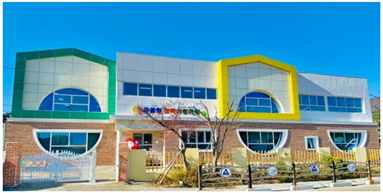 |
| Location | Cheolma-myeon, Gijang-gun, Busan, Republic of Korea |
| Year of Construction | 1997 |
| Type | Public nursery school |
| Lot Area | 401.00 m2 |
| Gross Area | 418.35 m2 |
| Number of Floors | 2F |
| Division | Existing Item | Improvement Item |
|---|---|---|
| Wall and floor | EPS insulation (0.043 W/m2·K) | PUR insulation (0.024 W/m2·K) |
| Roof | EPS insulation (0.043 W/m2·K) | Glass wool (0.035 W/m2·K) |
| Window | 18 mm double-glazed glass (4.0 W/m2·K; SHGC 0.28) | 28 mm low-E double-glazed glass (2.3 W/m2·K; SHGC 0.34) |
| System | Existing Item | Improvement Item | ||||||
|---|---|---|---|---|---|---|---|---|
| Equipment | Capacity | Quantity | Efficiency | Equipment | Capacity | Quantity | Efficiency | |
| Heating | Electric boiler | 2700 L | 2 EA | 100% | Condensing gas boiler | 50 kW | 2 EA | 91% |
| Hot water | Electric water heater | 500 L | 1 EA | 100% | Electric water heater | 500 L | 1 EA | 100% |
| Cooling | EHP | Total 17.90 kW | 8 EA | COP 3.06 | EHP | Total 33.90 kW | 9 EA | COP 3.38 |
| Light | LED lighting | 1F: 3.99 W/m2; 2F: 2.30 W/m2 | LED lighting | 1F: 3.99 W/m2; 2F: 2.30 W/m2 | ||||
| Division | Primary Energy Consumption (kWh/m2·yr) | |
|---|---|---|
| Residential Building (X) | Non-Residential Building (Y) | |
| 1+++ | X < 60 | Y < 80 |
| 1++ | 60 ≦ X < 90 | 80 ≦ Y < 140 |
| 1+ | 90 ≦ X < 120 | 140 ≦ Y < 200 |
| 1 | 120 ≦ X < 150 | 200 ≦ Y < 260 |
| 2 | 150 ≦ X < 190 | 260 ≦ Y < 320 |
| 3 | 190 ≦ X < 230 | 320 ≦ Y < 380 |
| 4 | 230 ≦ X < 270 | 380 ≦ Y < 450 |
| 5 | 270 ≦ X < 320 | 450 ≦ Y < 520 |
| Division | Fuel (Gas) | Electricity |
|---|---|---|
| PEF | 1.10 | 2.75 |
| Division | Heating | Cooling | Hot Water | Lighting | Total | |
|---|---|---|---|---|---|---|
| Energy demand (kWh/m2·yr) | Before GR | 52.8 | 6.2 | 6.1 | 4.6 | 69.7 |
| After GR | 39.7 | 7.0 | 6.1 | 4.6 | 57.4 | |
| Energy Consumption (kWh/m2·yr) | Before GR | 56.9 | 1.6 | 22.2 | 4.6 | 85.3 |
| After GR | 45.0 | 1.8 | 22.2 | 4.6 | 73.6 | |
| Primary Energy Consumption (kWh/m2·yr) | Before GR | 170.6 | 4.4 | 60.9 | 12.6 | 248.5 |
| After GR | 50.6 | 4.8 | 60.9 | 12.6 | 128.9 | |
| Primary Energy Consumption for BEEC Grade (kWh/m2·yr) | Before GR | 318.4 | 8.2 | 74.4 | 17.3 | 418.3 |
| After GR | 95.3 | 9.1 | 74.4 | 17.6 | 196.4 | |
| Division | Energy Consumption (kWh/m2·yr) | ||
|---|---|---|---|
| Fuel (Gas) | Electricity | Total | |
| Before GR | - | 85.3 | 85.3 |
| After GR | 45.0 | 28.6 | 73.6 |
| Division | Fuel Cost | Electricity Cost | |
|---|---|---|---|
| Base Cost | Used Cost | ||
| Applied amount | 6.8822 KRW/kWh | 5230 KRW/kW | 69.93 KRW/kWh |
| Division | Fuel Used Cost (KRW) | Electricity Cost (KRW) | Total (KRW) | |
|---|---|---|---|---|
| Base Cost | Used Cost | |||
| Before GR [A] | - | 2,024,516 | 2,180,083 | 4,204,600 |
| After GR [B] | 113,183 | 2,024,516 | 730,954 | 2,755,470 |
| Cost saved [A − B] | −113,183 | - | 1,449,129 | 1,335,947 |
| Division | CO2 Emissions during the Building Operational Phase (kg/m2·yr) | ||||
|---|---|---|---|---|---|
| Heating | Cooling | Hot Water | Lighting | Total | |
| Before GR | 29.1 | 0.7 | 10.4 | 2.2 | 42.4 |
| After GR | 9.3 | 0.8 | 10.4 | 2.1 | 22.6 |
| Division | Volume of the Construction Materials (m3) | Density (kg/m3) | EC Coefficient (kgCO2eq/kg) | EC (kgCO2eq) | |
|---|---|---|---|---|---|
| Concrete | 2.0 | 2400 | 0.107 | 514 | |
| Brick | 6.9 | 1600 | 0.240 | 2631 | |
| Tile | 0.3 | 2200 | 0.480 | 267 | |
| Insulation | PUR | 4.0 | 35 | 4.260 | 601 |
| Glass wool | 4.9 | 48 | 1.350 | 315 | |
| Plasterboard | 0.1 | 1000 | 0.390 | - | |
| Window | 2.8 | 2450 | 0.590 | 4047 | |
| Total | 20.9 | - | - | 8375 | |
| Construction Items | Material Cost (Korean Won [KRW]) | Labor Cost (KRW) | Overhead (KRW) | Total (KRW) | Construction Cost (%) |
|---|---|---|---|---|---|
| Temporary work | 416,578 | 756,256 | - | 1,172,834 | 7.26% |
| Reinforced concrete | 73,540 | 46,192 | 923 | 120,655 | 0.75% |
| Steel frame | 4,608,329 | 3,673,126 | 871,866 | 9,153,321 | 56.67% |
| Masonry work | 1,329,975 | 2,032,017 | 39,039 | 3,401,031 | 21.06% |
| Metal work | 1,025,768 | 1,016,455 | 32,544 | 2,074,767 | 12.85% |
| Plastering work | - | 3265 | - | 3265 | 0.02% |
| Aggregate and transportation costs | 85,853 | - | 139,325 | 225,178 | 1.39% |
| Total | 7,540,043 | 7,527,311 | 1,083,697 | 16,151,051 | 100.00% |
| Items | Material Cost (KRW) | Labor Cost (KRW) | Overhead (KRW) | Administrative Cost, etc. (KRW) | Total (KRW) |
|---|---|---|---|---|---|
| Production cost of construction | 7,540,043 | 8,129,495 | 3,023,481 | 5,121,981 | 23,815,000 |
| Construction Items | Material Cost (KRW) | Labor Cost (KRW) | Overhead (KRW) | Total (KRW) | Construction Cost (%) |
|---|---|---|---|---|---|
| Common temporary work (Container office installation) | - | - | 1,427,466 | 1,427,466 | 1.30% |
| Temporary work (Scaffolding work, etc.) | 2,952,244 | 7,351,938 | 9216 | 10,313,398 | 9.37% |
| Reinforced concrete work (Concrete pouring, etc.) | 147,080 | 93,962 | 1878 | 242,920 | 0.22% |
| Structural steel framing work (Structural installation, etc.) | 830,538 | 975,161 | 178,610 | 1,984,309 | 1.80% |
| Masonry work (Brick masonry installation) | 2,657,937 | 4,320,539 | 86,164 | 7,064,640 | 6.42% |
| Tile work (Tile installation) | 81,576 | 519,563 | 12,870 | 614,009 | 0.56% |
| Carpentry work (Formwork, etc.) | 9,419,050 | 2,041,092 | 89,380 | 11,549,522 | 10.49% |
| Waterproofing work | 1,703,830 | 3,363,205 | 34,220 | 5,101,255 | 4.63% |
| Roof installation work (Panel installation, etc.) | 404 | 3344 | 66 | 3814 | 0.00% |
| Metal work | 13,945,611 | 3,517,720 | 112,483 | 17,575,814 | 15.96% |
| Plastering work | - | 2,305,423 | 41,644 | 2,347,067 | 2.13% |
| Windows (glass) work | 10,184,184 | 3,094,394 | 4922 | 13,283,500 | 12.07% |
| Painting work | 106,305 | 498,684 | 2478 | 607,467 | 0.55% |
| Demolition work | −1,387,813 | 4,651,921 | 18,840 | 3,282,948 | 2.98% |
| Aggregate and transportation (Coarse aggregates transportation) | 414,541 | - | 273,245 | 687,786 | 0.62% |
| Other work | 1,630,000 | - | - | 1,630,000 | 1.48% |
| Equipment installations work (EHP, Boiler, etc.) | 13,520,219 | 18,319,335 | 538,236 | 32,377,790 | 29.41% |
| Equipment materials (Pipe, valve, etc.) | 12,264,000 | - | - | 12,264,000 | 11.14% |
| Total | 56,205,706 | 51,056,281 | 2,831,718 | 110,093,705 | 100.00% |
| Items | Material Cost (KRW) | Labor Cost (KRW) | Overhead (KRW) | Administrative Cost, etc. (KRW) | Total (KRW) |
|---|---|---|---|---|---|
| Production cost of construction | 56,205,706 | 55,140,783 | 20,651,147 | 74,693,364 | 206,691,000 |
| Construction Items | Total Construction Cost for Separate Construction (KRW) [A] | Total Construction Cost for Concurrent Proceeding of Construction (KRW) [B] | Ratio of Cost Savings by Construction Item [1 − B/A] | Cost Savings by Construction Item (KRW) [A − B] | Total Ratio of Savings |
|---|---|---|---|---|---|
| Temporary work | 10,479,104 | 9,684,398 | 7.6% | 794,706 | 16.8% |
| Reinforced concrete | 363,575 | 303,248 | 16.6% | 60,328 | 1.3% |
| Steel frame | 2,597,179 | 1,625,838 | 37.4% | 971,342 | 20.5% |
| Masonry work | 6,372,551 | 5,152,729 | 19.1% | 1,219,823 | 25.7% |
| Metal work | 7,298,244 | 5,746,705 | 21.3% | 1,551,540 | 32.7% |
| Plastering work | 134,785 | 133,153 | 1.2% | 1633 | 0.0% |
| Aggregate and transportation costs | 412,570 | 273,245 | 33.8% | 139,325 | 2.9% |
| Total | 27,658,008 | 22,919,314 | 17.1% | 4,738,695 | 100.0% |
| Division | Existing Cost of Structural Retrofitting (KRW) | Cost after Excluding Overlapping Items with Green Remodeling (KRW) | Total Cost Savings (KRW) | Ratio of Cost Savings |
|---|---|---|---|---|
| Production cost of construction | 23,815,000 | 16,646,693 | 7,168,307 | 30.1% |
| Division | Production Cost of Green Remodeling Construction (KRW) | Production Cost of Structural Retrofitting (KRW) | Total (KRW) | Ratio of Cost Savings [1 − B/A] | |
|---|---|---|---|---|---|
| Performance improvement projects | Separation of construction | 206,691,000 | 23,815,000 | 230,506,000 [A] | 3.11% |
| Concurrent construction | 206,691,000 | 16,646,693 | 223,337,693 [B] | ||
| Construction Items | 50% Saving of the Labor Cost [A] (KRW) | With Process Optimization (100% Saving) [B] (KRW) | Additional Expected Cost Savings [B − A] (KRW) |
|---|---|---|---|
| Temporary work | 794,706 | 1,172,834 | 378,128 |
| Reinforced concrete | 60,328 | 83,885 | 23,558 |
| Steel frame | 971,342 | 1,663,744 | 692,403 |
| Masonry work | 1,219,823 | 2,235,831 | 1,016,009 |
| Metal work | 1,551,540 | 2,059,767 | 508,228 |
| Plastering work | 1633 | 3265 | 1633 |
| Aggregate and transportation costs | 139,325 | 139,325 | - |
| Total | 4,738,695 | 7,358,651 | 2,619,957 |
| Division | Construction Cost (Thousand KRW) |
|---|---|
| Floor Area (X) < 5000 m2 | 3976 |
| 5000 m2 ≦ X < 8000 m2 | 3912 |
| 8000 m2 ≦ X < 10,000 m2 | 3820 |
| X > 10,000 m2 | 3765 |
| Average | 3841 |
| Year | Consumption Cost (Thousand KRW) | GR Cost Saving (Thousand KRW) [B − A] | B/C Results after 10 Years [A/B] | |
|---|---|---|---|---|
| Before GR [A] | After GR [B] | |||
| 0 | 1,663,000 | 1,886,000 | 223,000 | 0.89 |
| 1 | 1,667,416 | 1,888,921 | 221,505 | |
| 2 | 1,671,730 | 1,891,775 | 220,045 | |
| 3 | 1,675,944 | 1,894,563 | 218,618 | |
| 4 | 1,680,062 | 1,897,286 | 217,225 | |
| 5 | 1,684,084 | 1,899,947 | 215,863 | |
| 6 | 1,688,014 | 1,902,547 | 214,533 | |
| 7 | 1,691,853 | 1,905,086 | 213,233 | |
| 8 | 1,695,603 | 1,907,567 | 211,964 | |
| 9 | 1,699,267 | 1,909,991 | 210,724 | |
| 10 | 1,702,847 | 1,912,359 | 209,512 | |
| Types of Daycare Centers | 2018 | 2019 | 2020 |
|---|---|---|---|
| National/public | 3602 | 4324 | 4958 |
| Social welfare foundation | 1377 | 1343 | 1316 |
| Incorporated/unincorporated organization, etc. | 748 | 707 | 671 |
| Private | 13,518 | 12,568 | 11,510 |
| Home-based | 18,651 | 17,117 | 15,529 |
| Cooperative | 164 | 159 | 152 |
| Workplace | 1111 | 1153 | 1216 |
| Total | 39,171 | 37,371 | 35,352 |
| Types of Daycare Centers | Number of Daycare Centers as of 2020 | Number of Buildings Subject to Green Remodeling | Construction Cost (100 million KRW) | ||
|---|---|---|---|---|---|
| Separation of Construction | Concurrent Proceeding of Construction | Cost Savings of Comprehensive Performance Improvement | |||
| National/public | 4958 | 2310 | 5326 | 5160 | 166 |
| Social welfare foundation | 1316 | 613 | 1414 | 1370 | 44 |
| Corporation, etc. | 671 | 313 | 721 | 698 | 22 |
| Private | 11,510 | 5364 | 12,364 | 11,979 | 384 |
| Home-based | 15,529 | 7237 | 16,681 | 16,162 | 519 |
| Cooperative | 152 | 71 | 163 | 158 | 5 |
| Workplace | 1216 | 567 | 1306 | 1266 | 41 |
| Total | 35,352 | 16,474 | 37,974 | 36,793 | 1181 |
| Division | Construction Cost (KRW) | |
|---|---|---|
| Net construction cost | Material cost | 61,930,153 |
| Labor cost | 60,441,224 | |
| Overhead cost | 22,745,228 | |
| Administrative and other costs | 78,221,088 | |
| Total construction cost | 223,337,693 | |
| Division | Construction Cost (KRW) | Expenditure (100 million KRW) | Coefficient | Employment Effect (Person) |
|---|---|---|---|---|
| Personnel expense employment effect | 83,186,452 | 1922 | 0.4973 | 3865 |
| Operating expense employment effect | 140,151,241 | 3238 | 0.8000 | 2590 |
| Fiscal expenditure on employment effect | 223,337,693 | 5160 | - | 6455 |
Disclaimer/Publisher’s Note: The statements, opinions and data contained in all publications are solely those of the individual author(s) and contributor(s) and not of MDPI and/or the editor(s). MDPI and/or the editor(s) disclaim responsibility for any injury to people or property resulting from any ideas, methods, instructions or products referred to in the content. |
© 2023 by the authors. Licensee MDPI, Basel, Switzerland. This article is an open access article distributed under the terms and conditions of the Creative Commons Attribution (CC BY) license (https://creativecommons.org/licenses/by/4.0/).
Share and Cite
Cho, J.-H.; Bae, S.; Nam, Y. Analysis of the Energy and Economic Effects of Green Remodeling for Old Buildings: A Case Study of Public Daycare Centers in South Korea. Energies 2023, 16, 4961. https://doi.org/10.3390/en16134961
Cho J-H, Bae S, Nam Y. Analysis of the Energy and Economic Effects of Green Remodeling for Old Buildings: A Case Study of Public Daycare Centers in South Korea. Energies. 2023; 16(13):4961. https://doi.org/10.3390/en16134961
Chicago/Turabian StyleCho, Jeong-Heum, Sangmu Bae, and Yujin Nam. 2023. "Analysis of the Energy and Economic Effects of Green Remodeling for Old Buildings: A Case Study of Public Daycare Centers in South Korea" Energies 16, no. 13: 4961. https://doi.org/10.3390/en16134961
APA StyleCho, J.-H., Bae, S., & Nam, Y. (2023). Analysis of the Energy and Economic Effects of Green Remodeling for Old Buildings: A Case Study of Public Daycare Centers in South Korea. Energies, 16(13), 4961. https://doi.org/10.3390/en16134961






